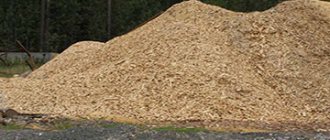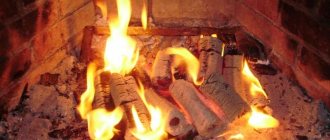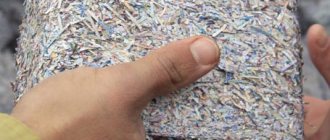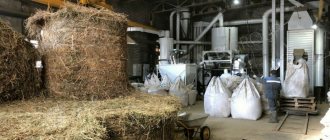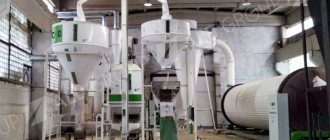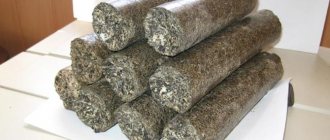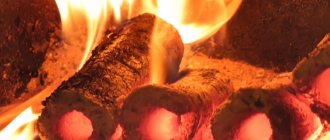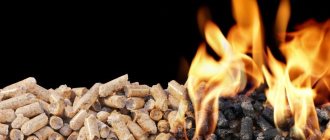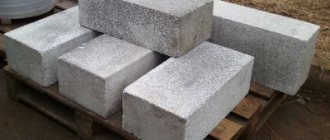The problem of complete waste disposal has long been dealt with in various fields of activity.
The goal of using forest waste 100% has not yet been achieved.
Fuel pellets and briquettes obtained from wood waste make it possible to achieve this already in our time.
Processing of timber, sawing and processing waste has never been so pressing before, except in those regions where there is no commercial timber left at all.
Today, the introduction of new technologies for deep processing of wood waste is becoming increasingly profitable.
Fuel briquettes and pellets - what are they?
Wood briquettes and pellets (fuel - general group) are products made from modified wood (standard designation).
This group includes both briquettes and pellets made directly from wood sawing waste, and those made from all other organic raw materials that have the ability to burn.
Classification
- White. The highest quality pellets. They are produced purely from wood sawing waste with minimal bark content. These pellets have:
- highest calorific value,
- lowest ash content,
- the highest price on the market.
- Gray. Produced from raw materials with a high content of bark and soil inclusions. Their calorific value is lower, their ash content and weight are higher. Applicable in:
- private use in pellet boilers,
- small boiler houses.
- Industrial. Made from:
- peat,
- coal,
- solid waste,
- other industrial waste.
- Agropellets. Made from husks:
- seeds,
- straw,
- other agricultural waste.
Pellets are characterized by the following granule characteristics :
- diameter - from 6 to 25 mm;
- length - from 5 to 50 mm;
- density - from 1000 to 1400 kg/m3;
- humidity - from 8 to 10%;
- bulk mass - 500 - 600 kg/m3;
- ash content - maximum 5%;
- abrasion.
The main characteristics and calorific value of pellets, depending on their type, are shown in the table:
| Type of pellets | Heat of combustion | Humidity | Ash content |
| “White” - premium pellets, made from wood without bark | 17.2 MJ/kg | 8%-10% | 0.3% |
| Industrial | 17 MJ/kg | 8%-10% | 0.7% |
| Agropellets | 15 MJ/kg | 8%-12% | 3% |
Fuel briquettes are mainly made from wood, but production technology is divided into several different areas . Let us consider them in more detail below, since the manufacturing principle is conventionally divided into two directions, each of which includes several subtypes.
Advantages and disadvantages of pellets
Like any product, pellets and briquettes have their pros and cons.
Advantages
The undoubted advantages immediately include the fact that wood in the form of pellets compared to ordinary firewood:
- takes up less volume;
- has lower humidity, which allows it to release more heat.
Pellets have a high bulk density, which allows them to be transported with high efficiency and minimal labor costs.
Standard for pellet transportation:
- in bags,
- in big bags,
- in cars for bulk materials on railway transport.
We will not consider low environmental impact in detail.
We will limit ourselves to information about low ash content and low CO2 emissions .
During the combustion process, pellets release the same amount of carbon dioxide as was consumed by the plant during growth.
Flaws
The only disadvantages are:
- errors in transportation;
- the lack of a clear supply of pellets to certain areas where people use pellet boilers.
In other words, you need to have a strategic supply of pellets for different occasions. In the case of transportation, there is a possibility that the pellets will gain moisture, but this can be solved by additional natural drying at the point of use .
Although pellets are transported in closed containers using moisture-proof shells, there may be situations when transport is carried out in bulk, without any protective measures.
Where can it be used?
The use of fuel pellets is widely regulated abroad. In Russia, pellets have so far found wide use only in the western regions of the country, where the processing of wood waste is already an established industry.
Along with solid fuel, electric and gas boilers, anyone can install a pellet boiler as an alternative. This allows you to be independent of gas or electricity prices. Whatever one may say, in terms of firewood or electricity, pellets remain the winner on all counts .
In addition to private use, pellets are widely used in production as an alternative to purchased coal fuel or other types of fuel. An example is woodworking production, which uses drying chambers and its own heating system in the autumn-winter period.
Own production of pellets provides benefits on several points:
- Full use of all wood waste, starting from the forest plot.
- Reduces costs for cleaning and disposal of waste after cutting trees. Consequence:
- minimum workers
- lower cost of timber harvesting.
- Complete recycling of wood waste allows you to abandon the purchase of energy resources for heating areas and the services of thermal power plants and switch to heating on your own. In practice, this results in enormous savings.
Introduction
More and more people understand that granulated herbal mixtures are much healthier for animals, and granulated wood provides several times more heat than ordinary firewood.
Buying a granulator is not always possible, and then craftsmen have the opportunity to train their brains and make a home masterpiece, from which the soul will rejoice for a very long time.
If, after reading this, you decide that it is more profitable for you to buy a press, then contact me at “SUPPORT”. Today there are lines or separate presses both for home use and for small-scale production.
If you contact me, I will tell you which press is best for you to choose, we will select the productivity and even you will be able to visit a real pellet plant for FREE. More details about my services can be found in the “SERVICES” section. I also have an interesting, inexpensive book, which you can find out about in the “MY BOOKS” section.
Production
The production of pellets cannot be called a complex process, but it requires high-quality equipment.
If in the production of wood concrete an important element of production was a chip cutter, then in the case of the production of wood pellets it is only one of a number of necessary ones, but not the most expensive.
The heart of production is the granulator press .
It is he who produces the final product - pressed wood pellets .
It is often possible to simplify production by substituting technological cycles. However, in the production of pellets, simplification is only permissible in the design of the press, which is directly related to the productivity of the installation.
The granulator, which is used in the production of feed from meat and bone meal, and the granulator, which is used in the production of pellets, are very similar in appearance.
Despite the similarities, a feed granulator will not be able to produce pellets with a density normal for fuel pellets due to:
- features of the materials used;
- calculated loads.
Why this happens - we will consider in detail below.
Technology
The production technology of pellets, like most types of briquettes, is based on lignin .
This substance is released during the direct production of pellets (briquettes).
In order for the pellets to be obtained in accordance with the required parameters, several rules must be followed, thanks to which the desired product is obtained.
At the entrance we do not always have either pure sawdust or sawdust cuttings.
Branches from plots in the forest can also be used as raw materials. But this is profitable when the production itself is nearby. The raw materials can be:
- sawdust,
- shavings from the workshop.
The essence of the technology is to give raw materials, regardless of their original appearance, the required dimensions and moisture content immediately before pressing.
Stages
Chip cutting
The very first stage, when wood waste is chopped into chips for subsequent drying.
The nuances lie in the dimensions of the raw materials.
If the production of pellets is powerful, with noticeable ratios in terms of the mass of products produced per hour, then the equipment can easily grind into chips without pre-treatment:
- stumps,
- trunks of fallen trees,
- other waste.
An ordinary PM-200 type chipper can process only branches and twigs that do not exceed the size of the neck of the loading opening.
Screw and rotary chippers for large-sized wood waste belong to a higher class of equipment; they allow processing several tons of wood per hour.
Drying
Drying wood chips is necessary for two reasons, and compliance with these standards is important for the correct completion of the technological process. Initial drying is achieved by laying the wood chips in piles, without forced drying on drying lines, although such an initial option is also possible.
The initial cutting into chips does not always give the result that is expected from a chipper. Before sending the resulting wood chips for regrinding, it must be dried, since the principle of operation of the grinder is based on the physical properties of dry wood chips , not raw wood.
The second important point is that for the release of lignin contained in wood cells and for gluing particles in the press, a certain humidity , and this humidity is also regulated from the point of view of the quality of the resulting product.
Regrinding
Adjusting the size of the chips to sizes acceptable for processing in a granulator is the next step after drying.
Additional grinding of woodchips is carried out in hammer mills .
As a result, the size of the raw material is reduced to values of no more than 4 mm in any dimension.
This standard size of raw material can also be obtained if you have a flake machine .
Raw materials enter it in the form of:
- wood chips
- roots,
- stumps,
- branches,
- trimmings from the sawmill.
It is precisely because of the size of the granulator matrix that compliance with the size of the raw material fraction is required.
Hydration
The quality of the product exiting the granulator is regulated by the moisture content of the raw materials. The average humidity of sawdust or crushed wood chips entering the granulator press should range from 7 to 10%, since this is the most optimal ratio of the moisture content of the raw material to its volume .
Humidity, as mentioned above, is better to bring it from the minimum value to the optimal value, rather than setting up drying lines for raw materials with sampling and moisture measurements.
In drum-type humidifiers, the raw materials passing through the drum hopper are processed with hot steam, which penetrates the mass of raw materials and condenses on the surface of the sawdust. This is the best option for hydration.
The ratio of water molecules in steam in terms of volume allows you to narrowly regulate the total volume of water for the entire passing mass of raw materials.
Production
A press granulator for the production of pellets has a so-called matrix .
It may be:
- flat metal surface
- round (cylindrical).
Flat die presses originally designed for use where high pressure was not required at the contact points:
- in feed granulators,
- for the chemical industry.
Presses with a round matrix were created from the very beginning for the production of pellets. After the start of using rollers and flat dies made of high-alloy metals and alloys, it became possible to use models of granulators with flat dies in the production of pellets.
The matrix in its structure is a metal part with a thickness of 3 cm, with holes from 6-10 mm, depending on the performance.
Rollers in the contact zone with the matrix create crushing of the raw material due to pressure and push the mass through holes in the matrix , at the exit from which knives cut off the emerging cylindrical granules.
The operating temperature in the contact zone can reach high temperatures , but the optimal temperature is considered to be 100-120 degrees Celsius.
It is at this temperature, when the fibers and cells of wood are crushed, that the lignin released under the influence of moisture in the raw material glues the wood pulp together. In this case, the compaction of wood in comparison with the incoming raw materials reaches three times the size.
It is strictly not recommended to exceed the established temperature and humidity thresholds. At excessively high temperatures and normal humidity, high-quality gluing of wood raw materials does not occur, and at increased humidity, the steam inside the pellets breaks the pellets themselves.
These reasons can negate the entire granulation process with a high percentage of defects.
Therefore, many models of granulators also have a built-in pellet cooler. If all requirements for temperature and other conditions are met, the output is granules of very high quality . We will look at examples of equipment below.
Equipment
Equipment for the production of wood pellets is produced by many enterprises. Let us briefly consider the main models of machines for the production of sawdust pellets.
Domestic manufacturers
- Pellet press MZLP-200, Moscow.
- productivity up to 100 kg per hour,
- engine power 5.5 kW/h,
- granule diameter 6 mm,
- price 150 thousand rubles.
- Chip cutter MP-5, Izhevsk.
- productivity 5 m3/hour,
- engine power 40 kW/hour,
- cost from 190 thousand rubles.
- Hammer chopper MI-3, Izhevsk.
- productivity 1 ton per hour,
- engine power 40 kW/hour.
- costs from 360 thousand rubles.
- Aerodynamic drying, LLC “Kupets”, Perm.
- total power 7 kW/hour,
- productivity up to 400 kg/hour,
- price 15.6 thousand USD.
Foreign manufacturers
- Dryer drum for pellet raw materials, Germany-China, supplier "AsiaTechnoImport", Novosibirsk.
- total power 15 kW/hour.
- dimensions 1.5 x 12 m.
- Press granulator CPM (California Pellet Mill), USA/Netherlands.
- productivity up to 5000 kg per hour,
- engine power from 90 to 500 kW/hour,
- diameter of granules depending on model,
- price from 160 thousand euros.
- SKJ2 series pellet granulator, Germany-China.
- engine power 3 kW,
- productivity up to 50 kg/hour,
- cost 80 thousand rubles.
- Cooling hopper for pellets SKLN, Germany-China.
- engine power 60 kW/hour,
- productivity up to 1500 kg/hour.
The process of making pellets in production is presented in the video:
How to distinguish high, premium quality pellets from substandard fuel?
When purchasing pellets, you need to pay attention to:
- the surface of the material must be smooth, shiny, without signs of deformation (swelling and microcracks);
- diameter (this parameter is established by the standards, the minimum value is 4.00 mm, the maximum is 10 mm, also standard are fuel pellets that have a diameter of 6.00 and 8.00 mm, please note that a pellet boiler operates on pellets of a certain fraction);
- length (this parameter should be about 20.00 - 30.00 mm, this is the optimal value, although the equipment can work on pellets with a length of over 50.00 mm);
- smell (the granules should have a slightly sweet smell of freshly prepared glue, this is a clear sign of excellent quality);
- color (it is important to remember that the highest quality pellets are white or slightly cream-colored, agropellets are predominantly dark, and in wood pellets, dark color indicates that bark, other impurities have been added, or wood species have been mixed);
- dust (there should be a minimum amount of dust on pellets, so it is better to buy fuel in sealed packaging);
- impurities (the presence of non-combustible impurities in the granules themselves can only be checked by burning them and determining the residue in the form of solid particles).
Fuel briquettes
There are two main types of fuel briquettes, which differ both in the manufacturing method and in the characteristics of the product. From these two types, folk craftsmen took some of the principles and introduced them into household production. Some are more successful, some are not.
Briquettes, as a heavier type of pellets, are widely used in everyday life.
RUF briquettes
The first type of briquettes is produced according to the original method of the RUF company, which is characterized by the production of rectangular briquettes on a hydraulic press.
They are made from sawdust or similar raw materials at a pressure of 200-300 atmospheres.
Briquettes have the appearance of light-colored bricks , with a clearly visible sawdust structure.
Machines based on the RUF methodology have a longer service life without intervention for service than PINI KAY machines, and this is caused by increased wear of the screw in the contact area with the outlet hole.
PINI KAY briquettes
The second type of briquettes, using PINI KAY technology, is produced using screw presses (like in a meat grinder).
They are characterized by the presence of high pressure in the briquette formation zone followed by heat treatment.
These briquettes look like hexagonal-octagonal cylinders with a hole inside.
On the outside they have a dark brown color due to heat treatment, which increases their strength and significantly increases the burning time.
Compared to RUF briquettes, PINI KAY briquettes have:
- longer burning time,
- high calorific value.
This compensates for the balance of power in the sales market.
There is a third type of equipment for the production of briquettes. It is a combination of some technologies from the first and second manufacturers. The production method of this equipment is shock-hydraulic.
The required impact pressure is created:
- hydraulic press,
- press of a single crank design.
The electric motor rotates the flywheel, which, through a transmission mechanism, repeatedly increases the moment of force and transmits it to the piston, which compresses wood raw materials in the contact zone .
Briquettes are mainly used as an alternative to ordinary firewood, as fuel for solid fuel boilers. While pellets can be dosed automatically using additional devices, briquettes in most cases are placed manually.
Making briquettes at home
With proper study of the essence of the technology, it is quite possible to make fuel briquettes with your own hands. The difference in quality will only be whether it is possible to achieve the required pressure in the mold or not. Let's consider several options for making briquettes.
Method No. 1: Folk
From metal 4 mm thick you need to weld forms combined into one.
A lid will fit into it complementarily, into each of the square cells, and have free movement almost to the middle of the depth of the mold.
Next, you will need to weld some kind of frame, at the base of which there will be a base on which the mold .
After laying the sawdust mass, abundantly moistened with water, a lid is placed on top and, using an ordinary hydraulic jack, the sawdust is compacted into the molds.
Method No. 2: Kulibinsky
The essence of the method is to find a single-crank press, fine-tune it to the desired state in order to increase the piston stroke from the original 5 cm to 20 cm. This is done by adding an eccentric to the design of the crank mechanism and changing the press bed to install a sawdust receiving sleeve. The method is suitable for small sawmills. There are a lot of options for this modification:
- increasing the diameter of the liner and piston,
- reducing the diameter of the liner and piston,
- increase in press productivity per unit of time, etc.
Method No. 3: Private enterprise
It comes down to the fact that when gathering an initiative group, collect the necessary components and manufacture a simple press according to the drawings .
He can be:
- hydraulic,
- impact type,
- screw
Depending on the type chosen, you will need to purchase the necessary key components .
- For a screw press, this will be a matrix with a screw.
- For hydraulic you will need a hydraulic press.
- For percussion - you can just have a faulty press, or you can assemble it from something that can be structurally adjusted to the structure. The impact press is characterized by:
- powerful bed,
- powerful flywheel,
- relatively low engine power.
Next, technical literacy comes into play and the realization that the success of the venture will lie in solving technical issues.
The balance of the cost of finished equipment is directly proportional to the time spent on this equipment during design and manufacturing. You can simply find the drawings and make according to them.
To sum up the preliminary results: if there is a constantly replenished raw material base and a possible sales market, then why not?
conclusions
We looked at the drawings of the three simplest granulators that are suitable for home use. As I said, they go in order of increasing productivity from smallest to largest.
It is more preferable to make household granulators with your own hands for the production of compound feed; it is still recommended to buy them for wood. But I don’t mind that in some cases homemade ones are stronger than store-bought ones.
If you still want to make a sawdust press, then you need to make sure that all its elements have increased strength.
In addition, do not forget that for high-quality granulation, the raw material must have a moisture content of 10 - 12%.
In most cases, this is not possible without drying. Why am I saying this, so that it doesn’t turn out that you’ve been doing a press for a couple of months, but it doesn’t press sawdust? You can read how to dry sawdust in the article at this link.
But let me just say briefly that there are several ways to dry raw materials for pellets.
The first is tumble drying. The advantages of this process are:
- Small footprint;
- Process stability;
- Good performance.
The photo shows an industrial dryer.
The second method is drying the crushed wood in a dryer pipe, its advantages are the simplicity of the design, it is much easier to do if you have the materials and welding skills. The disadvantages include the large occupied area.
What is better - firewood or fuel briquettes?
The point is that this question cannot be answered unambiguously.
Fuel briquettes will benefit from the point of view of:
- warehouse characteristics,
- calorific value,
- time spent on direct use as intended by the buyer.
From a quality point of view, it all comes down to the quality of production.
As practice shows, unscrupulous manufacturers do not stay on the market for long . Therefore, if an announcement about the sale of briquettes has been observed for more than a year, most likely the quality is there. Another question is whether it is profitable to produce them in forested areas? It is profitable if it is sold in a place other than where production is carried out. Only a marketing genius will be able to sell people something similar to what they can get for free.
Charcoal production is a promising way to make money! Recycling waste as a type of business - how to combine profit with contribution to the environment, read here. All answers on car tire recycling: https://rcycle.net/tehnika/komponenty/organizaciya-biznesa-na-pererabotke-shin
Reviews
Reviews about fuel briquettes are usually positive if there is no possibility of connecting to gas or a free heat source. Here are some reviews:
- We have been heating with European wood for three years now, including peat briquettes. Very pleased! It's convenient and profitable. Gas has long been abandoned - prices are rising and rising.
- I recently bought RUF-type bricks for testing - nonsense! The boiler does not reach maximum power for a very long time, they burn and smolder, the temperature is not high. True, they flare up later, but for a very long time. In front of them, he stoked them with Pinikami - they burn much better, the temperature, like in a nuclear reactor, rises very quickly. But they cost obscenely more. Maybe I got some bad RUFs - wet!! Boiler DAKON 16 - but still RUFs burn much better than birch firewood - that’s a fact!
- RUF briquettes flare up worse when the boiler starts operating due to the lower surface-to-mass ratio. RUF (of those that are usually sold in stores - in general, the RUF company makes briquettes for other sizes of briquettes) has briquette sizes of 150x60x100 mm (the side size of 100 mm can sometimes be smaller). Pinikey briquettes usually have a size of 50x50x300 mm (300 mm - the length can sometimes be from 200 to 400 mm), and most importantly, the Pinikey briquette has a hole of about 15 mm. Due to this, the Pinikeevsky briquette flares up faster during a cold fire, but when throwing briquettes into the fire there is not much difference. But due to the absence of a hole in the RUFs and their more “dense” shape, it is possible to push more mass into the firebox.
Cost and sales market
At production costs, expenses will be based on the cost of electricity . In this regard, impact presses are most beneficial. They will part with sawdust at the sawmill with great pleasure, and they may also pay you money, but only until they understand that their waste is your income. In this case, they will already sell sawdust to you, but with a purely symbolic payment.
It is better to pack briquettes in vapor-proof packaging. Bags with a layer of polyethylene inside are perfect for these purposes. Everything else is calculated according to location and factors.
The sales market in the case of fuel briquettes appears as follows:
- owners of country houses;
- tourist bases with an emphasis on environmental friendliness and minimal harmful impact on nature from areas where there are no forests and the cost of firewood is high;
- owners of any objects that do not have the ability to connect to gas.
Pellet classification
The main regulatory document predetermining the production of pellets is the European Union standard EN 14961-2, adopted in January 2011, on its basis an international quality certificate EN Plus is issued. There are three classes of granular fuel:
- ENPlus-A1 – best premium quality, diameter up to 8.00 mm, ash content up to 0.70%, another name is “white granules”;
- ENPlus-A2 – with ash content up to 1.50%, also called industrial granules, can consist of mixed wood species;
- EN-B – standard quality, with ash content up to 3.00%, an alternative name for agropellets.
In terms of cost, the most expensive pellets are ENPlus-A1 class, the cheapest are EN-B class, it is better not to take substandard fuel.
